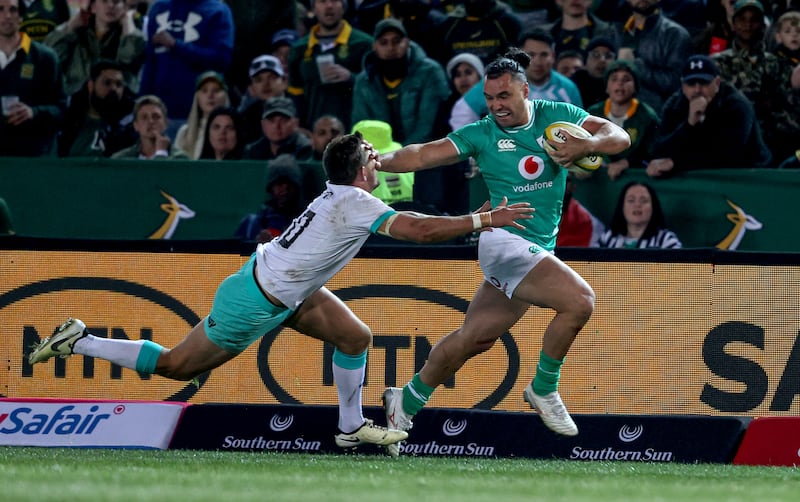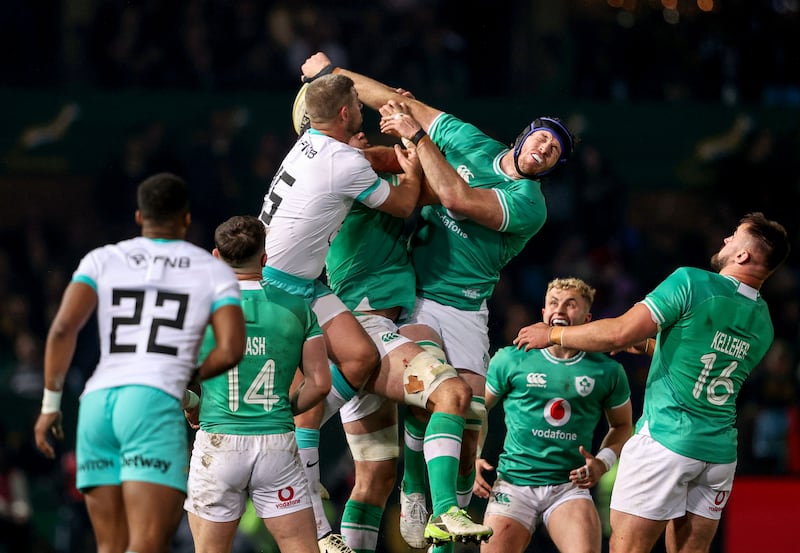It was déjà vu at the South Africa media briefing as national laws adviser Jaco Peyper answered questions in Durban just as he did last Monday prior to the first Test. It prompted an interesting and pertinent insight into several talking points during the Springboks 27-20 victory.
Peyper was first asked whether the interventions of the television match official (TMO) had more positive outcomes for South Africa. “It’s pretty simple, when it (an incident for review) goes on to the screen and it’s a TMO decision it’s got to be (a) factual based (view).”
The former Test referee referenced the review which saw Ireland left wing James Lowe’s try ruled out as a result of an infringement at a ruck spotted by TMO Ben Whitehouse, who accused replacement hooker Rónan Kelleher of hooking the ball back with his foot while on the ground.
Peyper continued: “The TMO has got eight angles at the same time and would have seen a few of those types of actions in the lead-up in different rucks. So if you get points scored from (one) they’re going to have to look at that turnover.
READ MORE
“Factually, the player is off his feet, and he turns over possession. Sometimes you don’t want to step in touch but you’re in touch. Sometimes you don’t want to make that turnover when you’re off your feet, but you still do it, even though you don’t mean it. Factually: off his feet, turnover made. So try can’t be scored.”
Kelleher is the victim of a neck roll at the ruck in question but Peyper glosses over this with a rather weak assertion that a similar incident happened to Springbok number eight Kwagga Smith a few minutes earlier. In essence he’s looking for mitigation from the fact that something else was missed rather than answering the question directly relating to a specific incident.

The South African asserted: “Then it becomes a debate whether it should be a penalty to Ireland because he was touched to the neck. That is debatable. Maybe the officials are trying to stay consistent because a few minutes earlier, there was exactly the same scenario on Kwagga Smith which was played through, so maybe that’s even-handed.”
He concludes with a rather wishy-washy: “That’s all in the game of rugby: you can’t referee everything, but you can’t leave stuff that’s high impact.”
Peyper was asked whether scrutinising every breakdown with the same forensics would lead rugby down a slippery slope in terms of the TMO interventions. “Yeah, I think if it’s a technical infringement but if it’s a player making a decision to go off his feet, I think that’s under a cynical infringement rather than a technical infringement.
“A player going off his feet, that would be my understanding of it. But if you look at that I think 10 seconds earlier there was a clear knock-on by (Craig) Casey behind the ruck, so I think we shouldn’t have got there.”

Peyper also felt that the right decision was reached following a TMO review of Cheslin Kolbe’s try. Referee Luke Pearce’s on-field decision was that a try had been scored and that Ireland wing James Lowe had kept the ball in play in the build-up.
“It’s fine margins, so they have to be very clear. It’s a big Test match so you’d rather have one replay too many than two too little. If the on-field decision is a try that means it stands until there’s evidence that proves otherwise.
“If they couldn’t prove (through the) facts that he touched the ground you have to stay with the on-field decision. If we were on the other side we would have felt aggrieved but if there’s a clear process it would have been followed.”
When asked about whether the balance of decisions favoured the home side, the former Test referee again referenced historical injustice. He said: “It’s (the outcomes) factually based. If you look at that try, two years ago in the Aviva, Ireland scored a try where the hooker kicked the ball out of the breakdown and Ireland got the benefit of the doubt that day. This time it went the other way. It’s fact-proven and follows the process.”
It will be interesting to see which way the cards fall on Saturday; hopefully without rancour.
















